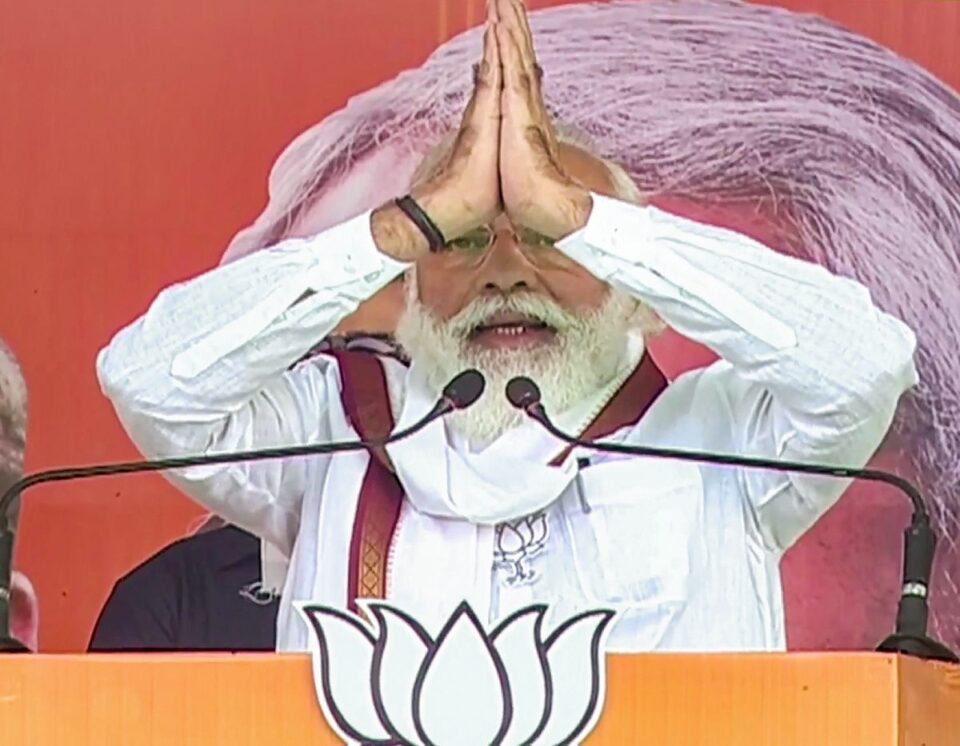An interplay of the Modi government’s outreach in Bihar and the sequence of events in Chirag Paswan’s life could make Bihar a game of musical chairs when the results are out, reports Sai Manish.
IMAGE: Prime Minister Narendra Damodardas Modi addresses an election rally in Darbhanga. Photograph: Screenshot from a video posted by @narendramodi on Twitter via PTI Photo
Something peculiar seems to be happening in Bihar. The state’s incumbent chief minister Nitish Kumar has become a common target of his allies and opponents alike.
The Bharatiya Janata Party may be trying hard to project itself as standing by Nitish, but unconfirmed reports say that many in the party want to end his twice interrupted decade long stint at the helm.
Then there is Chirag Paswan, former ally turned renegade openly baying for Nitish’s ouster. And then the Rashtriya Janata Dal-Congress alliance which is calling the CM a ‘tired man’ and projecting itself for a comeback after years in the wilderness.
The Bihari electorate, which like most of India invariably votes for their caste or the ones that would be most benevolent to theirs when in power, may have more than just that to contend with.
Both the Modi government at the Centre and the Nitish government in the state seem to have delivered on many economic parameters, especially over the last year-and-a-half in the run-up to the polls.
The Modi government, which owed part of its success in 2019 to the Ujwalla scheme which entails providing free liquified petroleum gas cylinders to rural households, has ensured that Bihar scores much better on this count than the rest of India.
85 lakh households in the state have been given these free LPG cylinders — half of the estimated rural households in the state.
While Bihar accounts for seven per cent of rural households in India, 10 per cent of all rural households in India who count themselves as beneficiaries of the cooking cylinder schemes are from the state.
“It is difficult to gauge the impact of such schemes. But I see the BJP-JD-U combine is definitely ahead at the moment. So definitely these policies have some role to play. But Bihar is about a lot more,” says Sanjay Singh of Centre for Study of Developing Societies.
IMAGE: Lok Janshakti Party President Chirag Paswan addresses a press conference in Patna. Photograph: PTI Photo
More astounding is the recent progress witnessed in Bihar under the ‘Har Ghar Jal’ scheme that aims to provide a working water tap connection in every rural household.
The scheme was launched on India’s Independence Day last year. At the time of launch only two per cent of Bihar’s rural households had a piped water connection.
By October this year, 55 percent of Bihar’s 17 crore (170 million) rural households had one. No other economically backward state has made as much progress as Bihar on this count.
The push for this key development work in Bihar far exceeds the progress made at the national level.
During the same period the number of rural households that had access to water tap connections went up from 17 per cent to around 30 per cent nationally.
While the scheme was conceptualised by the Modi government, the progress wouldn’t have materialised without the state government acting as a force multiplier.
The scheme is funded equally by the Centre and state governments. In the 2020-2021 Budget, the scheme was allocated Rs 11,500 crore (rs 115 billion).
It aims to provide every rural household in India piped water supply by 2024, when the Modi government would seek to return to power for a third consecutive term.
This Modi government hopes that this scheme will ensure similar electoral returns to its chances in 2024 that Ujwalla did in 2019.
The Nitish government too has been aggressive in its implementation and funding of this mission with similar political objectives in mind.
This becomes evident when one compares Bihar’s performance with other poorer states like Uttar Pradesh, Rajasthan and Madhya Pradesh; where progress has been a pale shadow of Bihar’s achievements.
There has also been an increase in the share of workers getting work under the Mahatma Gandhi National Rural Employment Guarantee scheme since 2015-2016 when the Nitish government came to power.
While notified wages have virtually stagnated under the scheme in Bihar as compared to the rest of India, the share of workers employed in Bihar has doubled from 2015 till 2019.
In 2015-2016, workers from Bihar accounted for almost four per cent of the employed MNREGA workforce in India.
While the average wage paid to a Bihari worker stagnated at Rs 177, the share of workers from the state almost doubled to seven per cent during this period.
IMAGE: Bihar Chief Minister Nitish Kumar addresses an election meeting in Muzaffarpur district, October 22, 2020. Photograph: PTI Photo
During the lockdown imposed by the centre in the wake of the Covid pandemic, something more remarkable seems to have happened.
A major chunk of the reverse migrants from cities in the wake of the lockdown imposed in March were headed to Bihar. Demand for work in rural areas witnessed a steep rise in the state.
From April to October, the average wage paid to workers increased to Rs 194. During this period direct cash transfers to poor households in the state also rose.
In 2020-2021, ten per cent of the Rs 1.8 lakh crore direct cash payments by the Modi government went to Bihar.
In the last few years, Bihar’s share in these cash subsidies was around seven per cent.
While complete details of PM Modi’s post-Covid lockdown cash transfer details are awaited, the amount of cash received by households in Bihar could be significantly higher since a sizeable chunk of the reverse migrants who escaped lockdowns in cities and for whom the relief was meant were from the state.
Bihar’s poor have also increasingly benefitted from the Modi’s government small loan scheme christened MUDRA.
In 2015-2016, just about 7 per cent of the 3.5 crore beneficiaries across India were from the state.
In 2018-2019, one out 10 beneficiaries across the country who got loans under the scheme accounting for seven per cent of the money disbursed were from Bihar.
While Modinomics has seen a heightened focus on Bihar off late, Nitish’s performance and the state’s 10 per cent gross domestic product growth rate that it has witnessed in recent years has more to it than meets the eye.
Bihar continues to be at the bottom of the pyramid when it comes to ease of doing business.
According to Reserve Bank of India figures, it had fewer factories in 2017-2018 as compared to 2015-2016 when Nitish became CM.
While invested capital in the state has grown much more than India’s, rural unemployment has reached astronomical levels.
Bihar has the highest rural unemployment levels among bigger states. It ranks next to Nagaland on this count among all states. Its rural unemployment rates are twice that of India’s.
Although rural agricultural and non-agricultural wages have increased in recent years, they still remain below the national level.
The per capita availability of electricity is just a fifth of what every other Indian has access to. Although per capita incomes have increased by almost a third during the Nitish regime, they still continue to be just a third of what every other Indian earns.
In many ways, Nitish’s economic success story seems to be plateauing. Although Bihar is growing, its people still seem to be as far behind other Indians in 2020 than they were in 2015.
Add to the mix the metamorphosed political dynamics unfolding this time around in Bihar and the going might just get tough for the JD-U.
A significant part of the damage that could potentially be done to JD(U) would come from Chirag Paswan’s Lok Janashakti Party.
Chirag would be hoping to ride the sympathy wave that came with the recent demise of his father Ram Vilas Paswan — a strong Dalit face in the state.
The LJP, which is part of the NDA alliance at the Centre repudiated, the offer of the BJP and JD-U for 25 seats in the upcoming elections.
Chirag Paswan raised the banner of revolt and decided to go it alone in 137 of the 243 seats. His party wouldn’t contest in any against the BJP, but would contest in all of them against the JD-U.
He continues to support the BJP and attack its ally JD-U openly. After his father’s demise, Paswan went as far as calling himself ‘Modi’s Hanuman’ and has been openly calling for Nitish’s ouster.
IMAGE: RJD leader Tejashwi Yadav addresses a gathering in Munger district. Photograph: PTI Photo
The three parties contested the 2019 Parliamentary elections together and won 39 of the 40 seats in the state.
The LJP swept all six seats that were assigned to it. A look at its performance shows that it won 35 out of the 36 assembly segments in the Parliamentary constituencies that the party won.
Bihar has 38 reserved assembly constituencies for Dalits and Ram Vilas Paswan’s demise would certainly sway voters in many of them.
If the LJP manages to perform even half as well as it did in 2019, it could end up bagging close to 50 seats across the state. Probably even more.
“Ram Vilas Paswan’s death wasn’t an untimely death. People knew he wasn’t keeping well for a long time. They will remember him as someone who already played his part in Bihar. So I do not see a big sympathy wave due to his death for Chirag,” adds CSDS’s Singh.
“Also remember that Bihar is sharply divided on caste lines. While Paswan was a tall Dalit leader he could never attract the votes of OBCs and other communities,” Singh points out
While Dalits comprise 15 per cent of Bihar’s population, BJP’s most loyal ‘twice born caste’ voters like the Brahmins and Bhumihars comprise around eight per cent.
That leaves three communities — the Yadavs, Kurmis and the Muslims — who together comprise more than a fourth of the state’s population to be wooed by the JD-U and the RJD-Congress combine.
The Yadavs are a vote multiplier — they not just manage to get themselves represented in large numbers as a proportion to their population (they are 11 per cent of population, but make up 25 per cent of the MLAs) but also bring on board votes of lower castes and Dalits over whom they exercise considerable economic influence in the rural hinterlands.
With Modi’s gas connections, water pipelines and cash transfers reaching the poor especially Dalit households in Bihar and with Paswan junior training his guns on the incumbent rather than his opponents, Nitish Kumar’s dream of becoming the longest serving CM of Bihar by winning the upcoming elections could well be more onerous than lifting the state out of decades old socio-economic destitution
Feature Presentation: Rajesh Alva/KhabriBaba.com




